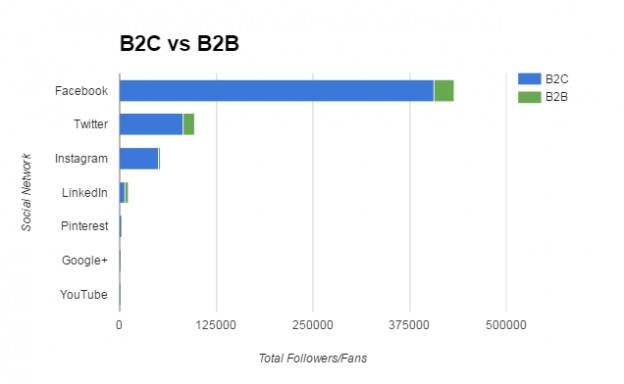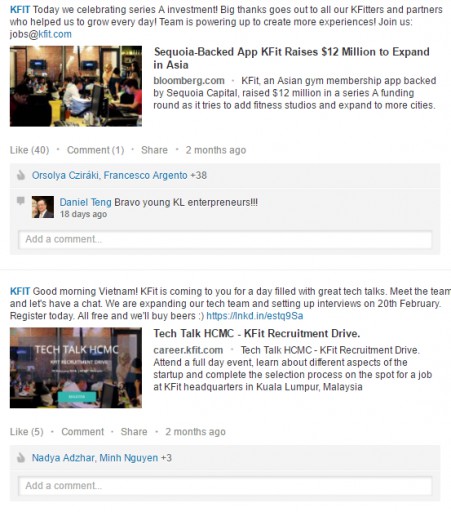If you’re a startup founder, these are important questions to answer. What social media channels you use, and what you share on them will impact your long-term marketing and communication strategy.
To help you find an answer, we looked at the social media habits of 50 startups across industries. Some of what we learned was expected, some was surprising, but nearly all of it was incredibly helpful.
Read on to find out…
I. How Startups Use Social Media
To figure out our list of startups, we followed a simple process:
- We searched for startups founded after 2015 on the Crunchbase startup database (since we were looking for early-stage companies)
- To weed out small websites listing on Crunchbase for backlinks, we only selected startups that have received at least some funding.
- From this, we selected 50 startups at random and gathered data from their social media accounts.
We focused our analysis on six social networks – Facebook, Twitter, Instagram, LinkedIn, Google+ and Pinterest. We left out Snapchat because very few businesses are active on it at the moment.
At the end of this exercise, this is what the data looked like:
In terms of funding, we had startups that had raised as much as $100M (Letgo.com) to as little as $7.5k (Zealr.co). On average, each startup on our list had $4.4M in funding ($2.51M after removing the $100M from Letgo.com – which heavily skewed the results).
We also had an equal distribution of B2C and B2B startups – 25 apiece.
From this list, this is what we found out:
1. Facebook is the most popular platform, Twitter is 2nd
Calculating the total number of followers/fans across social networks for all 50 startups, we found that Facebook dominates the field with a total of 432,543 fans.
| Social Network | Total Followers/Fans | Average Followers/Fans |
| 432,543 | 8,651 | |
| 96,941 | 1,939 | |
| 11,596 | 232 | |
| 52,307 | 1,046 | |
| 2,114 | 42 | |
| Google+ | 952 | 19 |
| YouTube | 776 | 15 |
This pie-chart illustrates things better:


The smaller social networks – Pinterest, Google+ and YouTube – are heavily under-represented. Between the two of them, Twitter and Facebook account for nearly 90% of all followers.
From this, we can see that:
- Facebook, Twitter and Instagram are the favorite platforms among early-stage startups.
- Pinterest has few takers, and Google’s properties – Google+ and YouTube – are clearly out of favor among early adopters.
2. Social media is for consumers
Looking at the spread of social media followers across B2B and B2C startups, something becomes very clear: social media is a B2C game.
Take a look at the followers for B2B and B2C startups across social networks:
B2B startups have just 8% as many followers as B2C startups. That’s a massive difference.


3. B2B startups prefer Twitter and Facebook
The spread of followers for B2B startups isn’t hardly uniform across social networks. Twitter and Facebook account for a bulk of the total followers, with average followers at 578 and 1,045 respectively.
Here’s a chart showing the total followers for all 25 B2B startups across all 7 social networks:
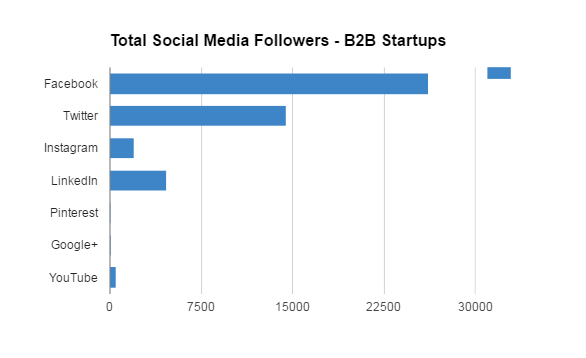

And here’s the same for B2C startups:


A couple of things stand out here:
- B2B startups have more followers on LinkedIn than Instagram – expected since LinkedIn is a business-focused network.
- B2B startups avoid visual social networks – Instagram and Pinterest – almost completely. On Instagram, for example, the average B2C startup has 2,013 followers. For B2B startups, however, this number is just 78.
- Pinterest and Google+ have almost no takers among B2B startups, accounting for a total of 2 and 50 followers respectively.
4. B2C startups prefer visual-focused social networks
Twitter might be great for sending out quick updates about your brand, but it’s not exactly the best way to show off a product or build out a brand.
For that, you need visuals, which is why B2C startups prefer image-focused social networks like Facebook and Instagram.
For example, on Facebook, B2B startups have just 6% as many fans as B2C startups:
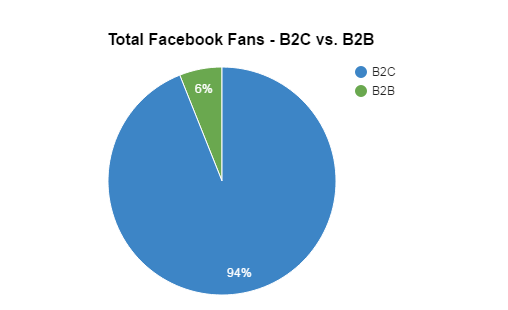

On Instagram, this figure is just 3.7%!


However, despite its image heavy content, Pinterest doesn’t do particularly well with early-stage startups – the average number of followers on this network is just 84.
5. Twitter is for early adopters
Unless you’ve been living under a rock, you’ve probably heard of Twitter’s growth struggles over the last couple of years.
Despite growing revenues, the company hasn’t managed to add a lot of new users. As a result, it has slipped behind Instagram to #6 in the social network rankings:
Among early stage startups, however, Twitter continues to be the #2 startup. For instance, in terms of total social media followers, Twitter comes second only to Facebook, and is far ahead of LinkedIn and Instagram:


There are two reasons for this discrepancy:
- Twitter’s format makes it convenient to send out company updates and connect and influencers.
- Early adopters prefer to use Twitter. According to one study, an overwhelming 53% of Twitter users say that they are early adopters. These are also folks who are more likely to follow an early-stage startup.
6. Twitter vs Facebook
In October 2014, Copyblogger announced that it would shut down its Facebook page with over 27k likes.
This was close on the heels of a bunch of other high profile businesses closing down their Facebook pages.
Their reason? Not enough interest from Copyblogger’s business-focused audience.
If we look at our numbers, it’s clear the Facebook has the largest number of total followers. Even the average number of followers on Facebook is 4x the next largest social network, Twitter – 8.6k vs 1.9k.
Looking at the median number of followers, however, tells a different story. The median for Facebook is 863 followers; for Twitter, it’s 560 followers.
The difference between average followers for these networks, on the other hand, is massive – Facebook has 8,651 followers on average vs. 1,939 for Twitter.


This is because a lot of startups have either no Facebook presence, or have under 500 likes, while EVERY startup at least has a Twitter account.
This chart should help you understand this better:


The majority of startups (29) have under 1,000 likes. 5 startups don’t even have a Facebook presence, while 4 others have under 100 likes. The numbers are skewed largely by a handful of startups with 50K+ likes (which have their own engagement problems – more on that below).
Contrast this with Twitter, where every startup has at least some presence, and the majority occupy the 100-1,000 follower range.


The takeaway is simple: startups might skip Facebook, but they almost never skip Twitter. If you’re looking to communicate effectively with customers and investors, you have to be present on Twitter.
This concludes the first half of this post. Next, we’ll look at what kind of content do startups actually share on these social networks, and what you can learn from them.
II. What Kind of Content do Startups Share on Social Networks?
Every social network has its own language, idioms and rhythms. Your followers won’t mind an occasional flurry of tweets, but they will mind a dozen pictures uploaded within minutes of each other on Instagram.
To see what kind of content works on social media, we looked at the content habits of the top performing startups on our list.
This is what we found:
1. Twitter
Out of all the early stage startups mentioned above, Cujo has the maximum number of followers on Twitter. This home security startup has over 23k followers and has sent out 4.8k tweets to date (for a follower:tweet ratio of 4.78:1).
Instead of coming up with their own tweets they tend to retweet other articles from different sources, mostly focused around security.
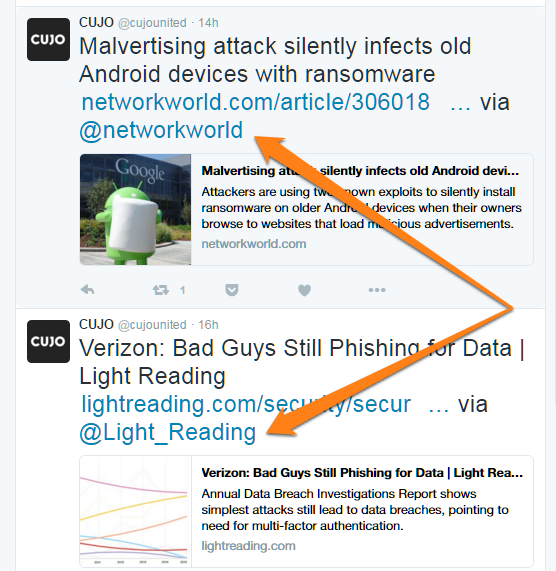

It is no surprise they keep their Twitter profile updated by posting at least 4-5 tweets a day.
Here’s a graph of their tweet frequency
Whether it’s BBC, Wired or a small security focused blog, they share it all, as long it as it aligns with what they do, “The Smart Way to Fight Home Hacking”.
The Takeaway
- Tweet multiple times a day
- Retweet content from other accounts
- Focus on educating and informing your followers instead of self-promotion.
2. Facebook
As we saw earlier, Facebook is surprisingly ignored by a lot of these startups. Poor alignment with their target market is one reason. Another is the lack of engagement.
Take a look at the top performing startup (in terms of total followers) on our list – KFit. This startup helps you discover, plan and book fitness, beauty and wellness activities near you.


It has a large number of likes – 102k and counting.
However, going deeper, we see that KFit’s fans show little to no engagement with their their page.
The ratio of people talking about it to the number of likes is very poor:


Contrast this with the engagement rate of a popular page like Buzzfeed:
Even KFit’s updates have very poor engagement, getting 1-2 likes at most.


This poor engagement could be due to the quality of their content, or (more likely), the quality of their fans.
So what kind of content does well on Facebook?
An example of a startup that is using Facebook the right way is Treebo Hotels. They share content regularly and get fairly good user engagement for each update:


Since they are a Hotel startup, they rely heavily on user feedback. They use video testimonials of their customers and post them on Facebook.


They also share general content to educate their users:


And they share company updates and promos as well:


A combination of all this gives them much better engagement rates than most of their peers in our list.
The Takeaway
- Experiment with different content types – photos, albums, videos and blog posts.
- Share both general purpose and promotional content.
- Visual content does particularly well on Facebook.
3. Instagram
Yadox tops our list in terms of Instagram followers (14,900). This shouldn’t be surprising – most fashion startups love Instagram.
Yadox’s Instagram strategy focuses on sharing high quality images that all follow the same template – a white background, the product, the price in hard-to-miss red, and the Yadox logo.
Yadox also does a pretty good job of using hashtags extensively in all its updates:
But it’s not all work – they also share funny and brand focused images
This is a good way to check the self-promotion and build out your brand.
The Takeaway
- Use strong visuals that fit into your brand identity.
- Use hashtags extensively to get more people to see your content.
4. Pinterest
Pinterest is largely ignored by most of the startups on our list. The top performing startup is Fliiby, a content publishing and monetization platform for artists and developers.
Helping people share photos easily is their primary purpose. So it makes sense for them to use Pinterest to share photos from different categories.
The images are repinned from Fliiby (thus driving traffic to the site) and include short descriptions. Note the use of hashtags.
The Takeaway
- Share visual content from your existing library on Pinterest instead of creating fresh content.
- Use strong descriptions and hashtags to promote your Pinterest content.
5. Linkedin
KFit has around 2k followers followed by Jumpshot.
Generally, these startups use LinkedIn as a hiring tool, not a marketing platform. Whatever content they do share tends to focus on company news.
Since LinkedIn plays a big part in the recruitment process, startups also share content about their workplaces:

The Takeaway
- LinkedIn is used best as a recruitment tool in the early stages of a startup.
- Focus on sharing insight about your company , its work culture, and hiring activities to potential employees.
6. Google+
Google Plus is mostly ignored by these startups. Almost every startup has a Google+ page but almost zero updates. These pages likely exist because Google makes one for you when you sign-up for Google apps.
Fliiby has the most number of subscribers on Google+ followed by Cujo.
They share an update almost everyday, though each update has little to no engagement:
This is in sharp contrast with their Twitter profile, where they often share updates multiple times a day (and sometimes, even multiple times in an hour):


The Takeaway
- Use Google+ only if you have the resources for it.
- Instead of creating new content for Google+, repurpose existing content from Twitter or Facebook.
7. Youtube
YouTube found almost zero takers in our list of startups. Video content is difficult to make and requires significant investment of time and money – two resources startups lack.
The only startup that is even remotely active on YouTube is Endurance Robots.
It makes sense for Endurance Robots to use Youtube. People would rather want to watch videos of robots than to see pictures of it.
Even though they don’t have many subscribers they do have a lot of content on the platform:
The Takeaway
- Ignore YouTube until you have enough resources to spare, or have an existing video content library.

